Osteichthyes is the largest class of superclasses Pisces under the subphylum Vertebrata (phylum: chordata). True bony fish belong to this category. They originated in the early Silurian period and in the middle of the Devonian period there was a massive adaptive dispersion between them. Among the vertebrates, the largest variety exists in bony fishes. Scientists believe that this diversity is in the interest of adaptation to the aquatic environment.
From the advent of bony fish about 40 million years ago to the present day, the increase in the number of species of this class of fish is particularly noticeable. About 30,000 species of bony fish have been described so far, and it is estimated that many species of bony fish are still undiscovered in the world’s water bodies. Now it is the diverse and abundant groups. It contains about 45 orders with over 435 families. Earlier, the class Osteicethyes was given the status of a valid taxon, but now there is disagreement among taxonomists on the question of its legitimacy.
Now the classes of bony fish are divided into 2 classes. One is Sarcopterygii and the other is Actinopterygii. Fish of the class Sarcopterygii are known as Lobe Finned Fish. Crossopterygian and lung fish originated from this group of fish of primitive nature.
Currently the fish called Latimaria survives as an example of the surviving Sarcopterygii class. Actinopterygii have led to the emergence of true bony fish. Although Sarcopterygii and Actinopterygii are described as two classes, most scientists now refer to Osteicethyes as a class while Sarcopterygii and Actinopterygii as subclasses. Fishery scientists believe that all the bony fish that are alive today should be divided into four main categories. These categories are similar to the categories of Bertin and Arambourg (1958). The categories are:
- Lungfish or Dipnoans
- Crossopterygians
- Actinopterygians
- Bichir fish or Brachiopterygians
Prominent fisheries scientist Romer reclassified the above 4 groups into 2 subclasses. He assigned the 1st and 2nd teams to Sarcopterygii and the 3rd and 4th teams to Actinopterygii. The following are the general and special features of the class Osteicethyes:
General Characteristics of Osteichthyes
- Lives in all types of lotic and stagnant water bodies.
- The body is spindle-shaped in most cases.
- The skeleton is mainly made of bone.
- The body is scaly or non-scaly.
- They have an operculum or gill covers.
- They also have air bladder or swimbladder.
- Numerous mucus glands exist in the body.
- Paired and unpaired fins are present in the body.
- Caudal fin is homocercal type.
- They have U-shaped stomach.
- The mouth is marginal or inferior.
- Usually completes the respiration with the help of 4 pairs of gills.
- The jaw or pharynx has teeth.
- Lateral-line sensory organs are well-organized.
- The kidneys of mature fish are of the Masonephric type.
- The olfactory lobes and cerebellum of the brain are miniature.
- Unisexual animals and fertilization is external.
- Genital organ is paired and development is direct.
- Most fish lay eggs.
Special Characteristics of Osteichthyes
- The skeleton of most fish is formed by bones, but the skeleton is composed of partial bone and partial cartilage in the Sarcopterygii subclass.
- Different types of scales such as Cycloid, ctenoid or ganoid scales are seen on the body.
- The tail fins are homocercal type.
- In addition to the gills, some fish have extra respiratory organs.
- There is an air sac or swimbladder in the body cavity.
- The gill cavity is covered by gill cover or operculum.
- The spiral valve is missing in the digestive tract.
- Anus is present in the body instead of the cloaca.
- Their internal ear has 3 semicircular ducts.
- Although it is monoceous animal, sexual dimorphism is not obvious.
- Egg retention and egg production capacity is high due to external fertilization.
- In some species, courtship and parental care are also visible.
Classification of Osteichthyes
Class Osteichthyes is divided into three subclasses. These are:
- Subclass-1: Acanthodii
- Subclass-2: Sarcopterygii
- Subclass-3: Actinopterygii
Subclass-1: Acanthodii
- At present they are extinct.
- They lived from the Devonian to the Permian period.
- These tiny fish lived in freshwater lakes, rivers and seas.
- The skin was covered with primitive nature ganoid scales.
- Except for the tail fins, the other fins had fin rays.
Example:Climateus, Acanthodius
Subclass-2: Sarcopterygii
- The skeleton is made up of partial hard bones and partial cartilage.
- The air sac changes into the lungs.
- The tail fin is of the diphycercal type.
- Mid region of paired fin is lobed.
- The nostrils are attached to the mouth cavity.
There are two super orders under this subclass:
Super order-1: Crossopterygii
- They are lobed finned fish.
- Body scales are cosmoid type.
- Cloaca absent.
- Air sac or swimbladder is reduced type.
Order-1: Coelocanthiformes
- There are two dorsal fins in the body.
- Caudal fin is three lobed and dephycercal type.
- Equal sized teeth present in the jaws.
Example:Latimaria
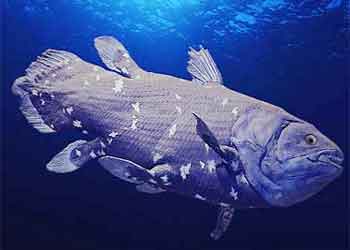
Image: Latimaria
Super order-2: Dipnoi
- The body is elongated and large.
- Dorsal fin one or absent.
- Air sac changes into lung-like organ.
- Caudal fin is dephycercal type.
- Cloaca is present in the body.
This super order includes two orders:
Order-1: Ceratodiformes
- Pectoral and pelvic fins are paddle-shaped.
- The body is covered by minute scales.
- One lung type air sac is present or it is bi-lobed.
Example:Neoceratodus (Australian lungfish)
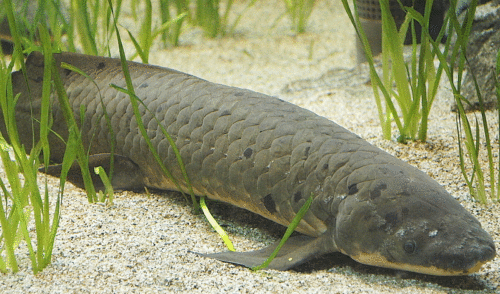
Image: Neoceratodus
Order-2: Lepidosireniformes
- Two lung-like air sacs or it is bi-lobed.
- The body is covered by minute scales.
- Pectoral and pelvic fins are tubular-shaped.
Example:Protopterus (African lungfish),
Lepidosiren ( South American lungfish)
Subclass-3: Actinopterygii
- Lobe fins absent.
- Fins contain fin rays.
- Skeleton is bony types.
- Caudal fin does not contain epicordal part.
- The body is covered by cycloid, ctenoid or ganoid scales.
Subclass: Actinopterygii is divided into three super order:
Super order-1: Chondrostei
- Skeleton is partial cartilaginous.
- Scale is ganoid type.
- Caudal fin is heterocercal type.
- Mouth is large and wide.
Super order-1: Chondrostei is divided into two orders:
Order-1: Polypteriformes
- Skeleton is made of mostly of bones.
- Scales are ganoid type.
- Dorsal fin contains sail type finlets.
Example: Polypterus
Order-2: Acipenseriformes
- Skeleton is made about of cartilage.
- A long rostrum is present in front of the head.
- The body is covered with bony plates or naked.
- Mouth sub terminal.
Example:Acipenser (Sturgeons), Polydon (paddle fish)
Super order-2: Holostei
- Skeleton is made mostly of bones.
- The body is covered with cycloid or ganoid scales.
- Mouth is comparatively small.
- Coudal fin is rudiment and heterocercal type.
Super order-2: Holostei is divided into two orders:
Order-1: Semlonotiformes
- The body is elongated with pointed snout.
- The scales are ganoid type and are obliquely arranged on the body.
- Small dorsal fin is present near the base of the caudal fin.
- The body is stout and cylindrical.
Example: Lepisosteus (Gar pike)
Order-2: Amiformes
- Snout is rounded.
- The body is covered with cycloid scales.
- Dorsal fin is elongated.
- Caudal fin is rounded and gephycercal type.
Example: Amia
Super order-3: Teleostei
- Skeleton is made of bone and weightless.
- The scales are of cycloid, ganoid or absent.
- The caudal fin is homocercal.
- Air sac or swimbladder is either present or absent.
- The premaxilla and maxilla are movabe.
This super order includes the following 31 orders, such as:
Order-1: Elopiformes
- The body is medium to large in size.
- The pelvic fin is situated at abdominal region.
- The lobe of caudal fin is deeply forked.
Example: Elopes, Megalops
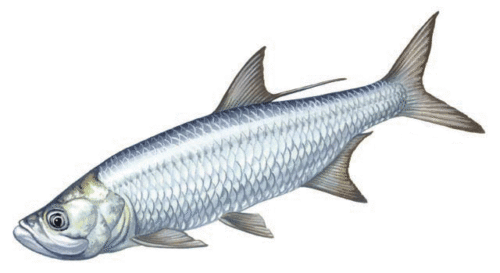
Image: Megalops
Order-2: Anguiliformes
- The body is elongated and slender.
- Pectoral and pelvic fins are absent.
- Dorsal and anal fins are attached with caudal fin.
- Scales are minute or absent.
Example: Anguila
Order-3: Notacanthiformes
- The body is slender and eel-like.
- The pectoral fin is situated at the abdominal region.
- The tail is elongated without caudal fin.
- They prefer to live in deep sea region.
Example: Notacanthus
Order-4: Clupeiformes
- The head and operculum are scaleless.
- The body is covered with cycloid scales.
- The fins contain soft fin rays.
Example:Tenualosa, Gadusia, Setipina
Order-5: Osteoglossiformes
- Fin rays are flexible.
- The bony tongue is present.
- The dorsal fin is small but anal fin is large.
Example:Osteoglossum, Notopterus
Order-6: Salmoniformes
- Fin rays are flexible.
- Pelvic fin is situated at the abdominal region.
- The dorsal fin is adipose type or fatty.
Example: Salmon, Esox
Order-7: Myctoptiformes
- Fatty or adipose fin is present
- Air sac or swim bladder is absent or filled with fat.
- The body contains florescent organ.
Example: Myctophum
Order-8: Cypriniforemes
- The swimbladder is 2-3 chambered and it is connected with pharynx.
- Weberian ossicle is present.
- Barbels are present around the mouth in some fishes.
Example:Labeo, Catla
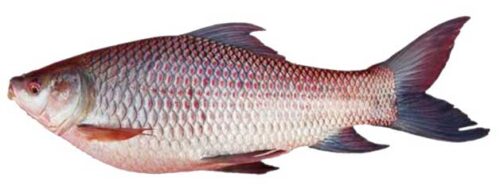
Image: Labeo
Order-9: Siluriformes
- Barbels are present around the mouth.
- The body is scaleless.
- The teeth are present in jaws.
- Adipose fin is present or absent.
Example: Clarias, Wallago, Mystus
Order-10: Beloniformes
- The body contains cycloid type scales.
- The dorsal fin is located just above the anal fin.
- The jaws are converted into rostrum.
Example:Xenontodon, Exocoetus
Order-11: Cyprinidontiformes
- Fins such as dorsal and pelvic fins are located at the posterior region of the body.
- The lips are movable.
- The body is covered with cycloid scales.
Example: Aplocheilus
Order-12: Echeneiformes
- Dorsal fin is converted into sucker organ.
- Swimbladder is absent.
- Other fins remain intact.
Example: Echeneis
Order-13: Lophiformes
- Thick pectoral fin is present.
- The body is dorso-ventrally flattened.
- The body contains florescent organ.
Example: Lophius
Order-14: Gadiformes
- In some species contain 3 dorsal and 2 anal fins.
- The fins contain soft fin rays.
- The pelvic fin is situated at the front side of the body.
Example: Gadus
Order-15: Syngnathiformes
- The body is slender and elongated.
- Dorsal and pectoral fins are small.
- The mouth is present at the terminal end of the rostrum.
Example: Hippocampus, Syngnathus.
Order-16: Pleuronectiformes
- The body is flattened and asymmetrical.
- The movable eyes are present at one side of the mouth.
- Dorsal and anal fins are large in size.
Example: Cynoglossus
Order-17: Channiformes
- They are called snake-headed fish.
- The head contains scales.
- The accessory respiratory organ is present.
Example: Channa
Order-18: Perciformes
- Pectoral fin is attached to head.
- Dorsal and anal fins contain both hard and soft fin rays.
- Swimbladder is present.
- The accessory respiratory organ is also present.
Example: Anabas, Colisa, Nandus
Order-19: Symbranchiformes
- The body is eel-like.
- Fin rays are absent in both dorsal and anal fins.
- Pectoral fin is absent.
Example: Ophisteron
Order-20: Tetradontiformes
- The body is rounded.
- The scales are spinelike.
- The jaws contain sharp teeth.
- Pelvic fin is absent.
Example: Tetradon
Order-21: Mugiliformes
- The body is elongated.
- The head is broad and flattened.
- Lateral line sense organ is present.
- The jaws contain small teeth or absent.
Example: Mugil
Order-22: Polynemiformes
- The body is elongated with two dorsal fins.
- Lateral line sense organ is present.
- Thread-like structure is present at the lower side of the pectoral fins.
Example: Polynemus
Order-23: Mastacembeliformes
- The body is slender and elongated.
- Some spines are present in front of dorsal fin.
- Nostrils are present at the end of the snout.
Example: Mastacembalus
Order-24: Scorpaeniformes
- The body is elonageted.
- The head is dorso-ventrally flattened.
- The body is covered with cycloid or ctenoid scales or absent.
- Pectoral and caudal fins are rounded.
- Numerous spines are present in head in most of the species.
Example: Scorpaena, Pterois
Order-25: Percopsiformes
- The head is large.
- Pelvic fins are absent in some species.
- Dorsal fin is adipose type in some species.
Example: Percopsis
Order-26: Gonorhynchiformes
- The heat region is more or less pointed.
- The mouth is small.
- Jaws are teethless.
- Pelvice fins are situated at the middle position ventrally.
Example:Chanos
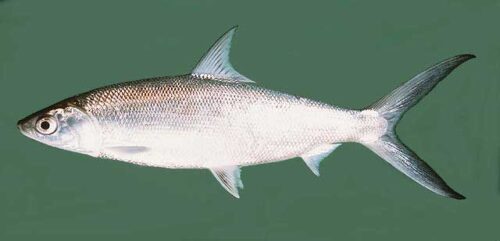
Image: Chanos
Order-27: Characiformes
- The body is more or less ovoid.
- The adipose fin is present dorsally.
- The jaws contain sharp and well developed teeth.
- Anal fin is large.
- Weberian ossicle present.
Example:Pygocentrus, Piaractus
Order-28: Scopeliformes/Aulopiformes
- The body is elongated and the posterior region is flattened.
- The mouth is large with teeth.
- A small adipose dorsal fin is present.
Example:Harpodon, Saurida
Order-29: Pegasiformes
- There are two dorsal fins and they contain spines.
- Dorsal and anal fins are small in size.
- The head region is elongated and pointed.
Example:Pegasus
Order-30: Beryciformes
- They are deep sea fish.
- The head region is broad.
- Two dorsal fins are present.
- The pelvic fin contains long spines.
- Caudal fin contains branched fin rays.
Example:Holocentrus
Order-31: Bastracoidiformes
- The body is elongated and the head region is dorso-ventrally flattened.
- Scales are present or absent.
- Spiny operculum is present.
- Two dorsal fins are present.
Example:Batrachomoeus trispinosus(three-spined frogfish)
